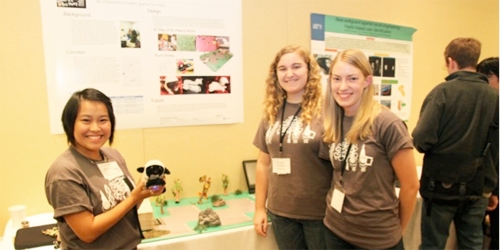How will people interact with computers in the future? Will the keyboard and the mouse become relics of the past?
CS 320 Tangible User Interfaces – Exploring the Future of Human-Computer Interaction
Orit Shaer, Clare Boothe Luce Assistant Professor of Computer Science and co-director of the Media Arts and Sciences program, teaches this advanced Computer Science course in which students explore the future of human-computer interaction. Inventing and constructing novel tangible user interfaces that diverge from traditional graphical user interfaces, students create user-computer interfaces that interlink the physical and digital worlds through sensors, actuators, and gesture recognition.
The course is structured around a semester-long team project in which students work together, designing and constructing tangible user interfaces of their own creation. Tangible interaction is an emerging field of research, and building novel tangible interfaces requires not only the application of existing concepts and practices but also the exploration of new ideas, domains, and techniques. Thus, in this course students are introduced to both the practice and theory of tangible user interfaces, learning about software design, electronics, aesthetics, and affordability. Shaer encourages students to take risks, experiment with new ideas and technologies, and present their work beyond the class, to the emerging and dynamic community of tangible interaction researchers.
During the fall 2011 semester, two teams of students presented their course projects at the student innovation contest of the prestigious User Interface Software and Technology Symposium, winning two awards. The first team created an “Air-Guitar” that allows non-experts to create and perform digital music through gestures. This project won First Place for Creativity. The second team created a board game for children, which integrates physical input with digital output and is called “Where is Bo Peep.” This project won Second Place for Usefulness. The previous fall, a team of students presented Morphess, a special dress that changes its form in response to user input, at the student design competition of the International Conference on Tangible Embedded and Embodied Interaction, winning honorary mention for presentation and style.





 “Through this course, I was given a singular chance to fully immerse myself in pertinent research that even resulted in presenting our project at an international conference in California.”
“Through this course, I was given a singular chance to fully immerse myself in pertinent research that even resulted in presenting our project at an international conference in California.”